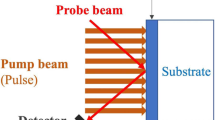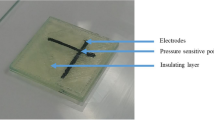Abstract
One of the methods, to improve the uniformity of a microhotplate is to provide an insulation layer of optimum dimensions between the heater and gas sensor. In this paper, two insulation layer material, silicon nitride and silicon carbide, are investigated. Simulation studies are carried out to find the optimum dimension of insulation layer, required for a targeted uniformity of 0.22 K/μm, a value comparable to the reported literature. With 8 μm thick silicon nitride layer, a thermal uniformity of 0.18 K/μm is obtained whereas the same is achieved with a 1.5 μm thick silicon carbide layer. Therefore, the deposition time in the whole process will significantly reduce by employing silicon carbide layer while retaining similar uniformity. It has been established that, the proposed method not only serves the purpose of providing electrical insulation and improve thermal uniformity but also improves the mechanical stability. The silicon carbide is compared with silicon nitride layer in terms of performance parameters and a table is also listed, highlighting the practical aspects involved in the choice of these two insulation layer materials.







Similar content being viewed by others
References
(2001) NSM Archive - Silicon Carbide (SiC). http://www.ioffe.rssi.ru/SVA/NSM/Semicond/SiC/, [Online]. [April-2013]
(2013) coventor.com. http://www.coventor.com/mems-solutions/products/coventorware/, [Online]. [April-2013]
Ahmed A, Dennis J, Saad M, Talah W (2008) Design and simulation of a high temperature MEMS micro-hotplate for application in trace gas detection, pp 153–157. doi:10.1109/SMELEC.2008.4770297
Arata H, Rondelez Y, Noji H, Fujita H (2005) Temperature alternation by an on-chip microheater to reveal enzymatic activity of β-galactosidase at high temperatures. Anal Chem 77(15):4810–4814
Briand D (2001) Thermally isolated microelectronic devices for gas sensing applications. PhD thesis, University of Neuchâtel
Briand D, Pham P, De Rooij N (2007) Reliability of freestanding polysilicon microheaters to be used as igniters in solid propellant microthrusters. Sens Actuators A 135(2):329–336
Chung GS, Jeong JM (2010) Fabrication of micro heaters on polycrystalline 3C-SiC suspended membranes for gas sensors and their characteristics. Microelectron Eng 87(11):2348–2352. doi:10.1016/j.mee.2010.04.005. http://www.sciencedirect.com/science/article/pii/S0167931710001309
Dennis J, Ahmed A, Mohamad N (2010) Design, simulation and modeling of a micromachined high temperature microhotplate for application in trace gas detection. Int J Eng Technol 10(02):89–96
Fu X, Dunning JL, Zorman CA, Mehregany M (2005) Measurement of residual stress and elastic modulus of polycrystalline 3C-SiC films deposited by low-pressure chemical vapor deposition. Thin Solid Films 492:195–202. doi:10.1016/j.tsf.2005.07.236. http://www.sciencedirect.com/science/article/pii/S0040609005009879
Kang T, Kim S, Cho Y (2002) High-impulse, low-power, digital microthrusters using low boiling temperature liquid propellant with high viscosity fluid plug. Sens Actuators A 97:659–664
Kim J, Chung J, Lee D, Kim Y, Kim J, Hwang S, Ju B, Yun S, Park H (2009) Development of temperature feedback control system for piezo-actuated display package. Sens Actuators A 151(2):213–219
Lam L, Sakakihara S, Ishizuka K, Takeuchi S, Arata H, Fujita H, Noji H (2008) Loop-mediated isothermal amplification of a single DNA molecule in polyacrylamide gel-based microchamber. Biomed Microdevices 10(4):539–546
Lee J, Spadaccini CM, Mukerjee EV, King WP (2009) Suspended membrane single crystal silicon micro hotplate for fifferential scanning calorimetry. In: Proceedings of the 22nd international conference on micro electro mechanical systems, IEEE, pp 852–855
Li T, Wu L, Liu Y, Wang L, Wang Y, Wang Y (2006) Micro-heater on membrane with large uniform-temperature area. In: 5th IEEE conference on sensors, 2006, pp 571–575. doi:10.1109/ICSENS.2007.355532
Liu F, Carraro C, Chu J, Maboudian R (2009) Residual stress characterization of polycrystalline 3c-sic films on si (100) deposited from methylsilane. J Appl Phys 106(1):013505–013505
Lu C, Setiadi D, Udrea F, Milne W, Covington J, Gardner J (2000) 3D Thermo-electro-mechanical simulations of gas sensors based on SOI membranes. Power [W] 500:600
Mele L, Rossi T, Riccio M, Iervolino E, Santagata F, Irace A, Breglio G, Creemer J, Sarro P (2011) Electro-thermal analysis of MEMS microhotplates for the optimization of temperature uniformity. Procedia Eng 25(0):387–390. doi:10.1016/j.proeng.2011.12.096. http://www.sciencedirect.com/science/article/pii/S1877705811057651
Mele L, Santagata F, Iervolino E, Mihailovic M, Rossi T, Tran A, Schellevis H, Creemer J, Sarro P (2012) A molybdenum MEMS microhotplate for high-temperature operation. Sens Actuators A 188(0):173–180. doi:10.1016/j.sna.2011.11.023. http://www.sciencedirect.com/science/article/pii/S0924424711006820
Mendoza-Acevedo S, Reyes-Barranca M (2011) Study for the micromachining optimization of micro hotplates used in MEMS-CMOS gas sensors. In: Proceedings of the 8th international conference on electrical engineering computing science and automatic control (CCE), IEEE, pp 1–6
Mo Y, Okawa Y, Inoue K, Natukawa K (2002) Low-voltage and low-power optimization of micro-heater and its on-chip drive circuitry for gas sensor array. Sens Actuators A 100(1):94–101. doi:10.1016/S0924-4247(02)00145-0. http://www.sciencedirect.com/science/article/pii/S0924424702001450
Naumann F, Ebert M, Hildenbrand J, Moretton E, Peter C, Wollenstein J (2009) Thermal and mechanical design optimisation of a micro machined mid-infrared emitter for optical gas sensing systems. In: Proceedings of the 10th international conference on thermal, mechanical and multi-physics simulation and experiments in microelectronics and microsystems, IEEE, pp 1–5
Rossi C, Temple-Boyer P, Esteve D (1998) Realization and performance of thin SiO2/SiNx membrane for microheater applications. Sens Actuators A 64(3):241–245. doi:10.1016/S0924-4247(97)01627-0. http://www.sciencedirect.com/science/article/pii/S0924424797016270
Saddow SE, La Via F, Severino A, Anzalone R, D’Arrigo G, Locke C, Volinsky A, Piluso N, Carballo J (2010) Growth rate effect on 3C-SiC film residual stress on (100) Si substrates. Mater Sci Forum Trans Tech Publ 645:143–146
Saxena G, Paily R (2012) Simulation study of power loss components in a microheater. In: 1st International conference on power and energy in NERIST (ICPEN), pp 1–5. doi:10.1109/ICPEN.2012.6492333
Saxena G, Paily R (2013a) Analytical modeling of square microhotplate for gas sensing application. Sens J IEEE 13(12):4851–4859 doi:10.1109/JSEN.2013.2275951
Saxena G, Paily R (2013b) Effect of membrane to heater ratio on the performance of square microhotplate. In: 2013 Annual international conference on emerging research areas and 2013 international conference on microelectronics, communications and renewable energy (AICERA/ICMiCR), pp 1–5. doi:10.1109/AICERA-ICMiCR.2013.6575982
Schmid U, Seidel H (2008) Effect of high temperature annealing on the electrical performance of titanium/platinum thin films. Thin Solid Films 516(6):898–906. doi:10.1016/j.tsf.2007.04.128. http://www.sciencedirect.com/science/article/pii/S0040609007007353
Smith R, Collins S (1990) Thick films of silicon nitride. Sens Actuators A Phys 23(1–3):830–834. doi:10.1016/0924-4247(90)87041-G. http://www.sciencedirect.com/science/article/pii/092442479087041G
Solzbacher F, Imawan C, Steffes H, Obermeier E, Eickhoff M (2001) A highly stable SiC based microhotplate NO2 gas-sensor. Sens Actuators B 78(1–3):216–220. doi:10.1016/S0925-4005(01)00815-2. http://www.sciencedirect.com/science/article/pii/S0925400501008152
Swart N, Nathan A (1994) Design optimisation of integrated microhotplates. Sens Actuators A 43(1–3):3–10
Velmathi G, Ramshanker N, Mohan S (2010) Design, electro-thermal simulation and geometrical optimization of double spiral shaped microheater on a suspended membrane for gas sensing. In: Proceedings of the 36th annual conference on IEEE industrial electronics society, pp 1258–1262. doi:10.1109/IECON.2010.5675550
Visvanathan K, Gianchandani Y (2011) Microheaters based on ultrasonic actuation of piezoceramic elements. J Micromech Microeng 21:085030
Vrinceanu I, Danyluk S (2002) Measurement of residual stress in single crystal silicon wafers. In: Proceedings of 8th international symposium on advanced packaging materials, 2002, pp 297–301. doi:10.1109/ISAPM.2002.990402
Xu L, Li T, Gao X, Wang Y (2011a) Development of a reliable micro-hotplate with low power consumption. Sens J IEEE 11(4):913–919. doi:10.1109/JSEN.2010.2064765
Xu L, Xu J, Wang B, Zhang W (2011b) Pool boiling heat transfer on the microheater surface with and without nanoparticles by pulse heating. Int J Heat Mass Transf 54(15):3309–3322
Yoon D, Cho YK, Oh K, Kim S, Kim Y, Han J, Lim G (2006) A microfluidic gel valve device using reversible sol–gel transition of methyl cellulose for biomedical application. Microsyst Technol 12:238–246
Acknowledgments
The authors are thankful to NPMASS, Government of India, for equipping the National MEMS Design Center IIT Guwahati with MEMS design softwares which were used for carrying out this work. The authors gratefully acknowledge Mr. Vijay S. Duryodhan of IIT Bombay and Mr. Dushyant Singh Raghuvanshi of IIT Delhi (India) for their valuable discussions.
Author information
Authors and Affiliations
Corresponding author
Rights and permissions
About this article
Cite this article
Saxena, G., Paily, R. Choice of insulation materials and its effect on the performance of square microhotplate. Microsyst Technol 21, 393–399 (2015). https://doi.org/10.1007/s00542-013-2022-6
Received:
Accepted:
Published:
Issue Date:
DOI: https://doi.org/10.1007/s00542-013-2022-6




